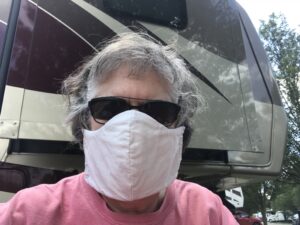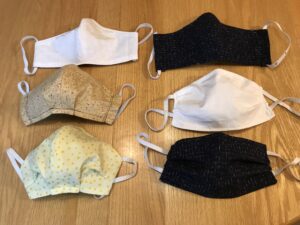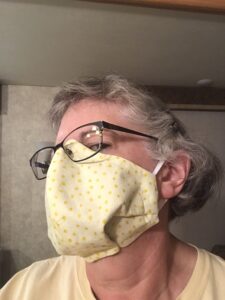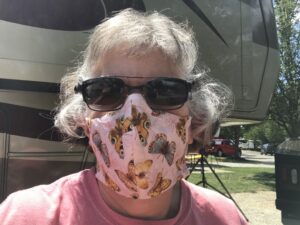A year ago I never imagined I would write a blog post on face masks. But, times have changed and our behavior has changed as well. Face masks are a fact of life, at least for a while. I understand the necessity of the masks and fully support wearing them whenever I am indoors or with other people.
But I have a couple of problems. The first is that my glasses fog up with the masks. People have suggested several remedies including putting shaving cream on them, but they don’t work for me. The second problem is that I don’t want to use a new disposable mask every day. They are cheap and relatively comfortable, but they add to the garbage problem.
The washable face masks I have tried are too small. When I talk they come down off my nose, increasing the problems with my glasses. Also, in order to be effective, they have to be thick.
 The easiest way to tell if a face mask is effective is the candle test. If you can blow out a candle through your face mask, it isn’t protecting you or others from much. So I decided to do some experiments with layers of cloth and a candle.
The easiest way to tell if a face mask is effective is the candle test. If you can blow out a candle through your face mask, it isn’t protecting you or others from much. So I decided to do some experiments with layers of cloth and a candle.
 First, I tried the face mask they gave us at the national park. It is really thick and heavy and it was impossible to blow out the candle. But it is also really thick and heavy and makes my glasses fog up like crazy.
First, I tried the face mask they gave us at the national park. It is really thick and heavy and it was impossible to blow out the candle. But it is also really thick and heavy and makes my glasses fog up like crazy.
Second, I tried the disposable face masks Tom and I keep in the truck. They are light and fairly comfortable. I can turn down the top edge which helps some with the glasses fogging up. But, after several tries and a huge breath, I was able to blow out the candle. Now, the only way I’m going to be breathing that hard is if someone is chasing me, so the disposable mask is probably good for most circumstances.
Third I tried two layers of cotton, which are the instructions on most homemade mask patterns. They always say “tightly woven cotton” but no matter how tightly woven the fabric was, I could blow out a candle without too much trouble.
Finally I tried two layers of cotton with a layer of interfacing in between. This worked as well as the really thick mask from the park service. So now I just had to find a design that worked with my glasses and was comfortable to wear.
 After two days of sewing and trying out various patterns (here is one) I didn’t get very far. I made six face masks that worked okay, but each had various flaws. The biggest problem is the interfacing. It may keep me from blowing out a candle, but it also makes the mask too stiff to conform closely to my face. And when I put in tucks, gathers, or pleats, I feel like I have too much cloth on my face.
After two days of sewing and trying out various patterns (here is one) I didn’t get very far. I made six face masks that worked okay, but each had various flaws. The biggest problem is the interfacing. It may keep me from blowing out a candle, but it also makes the mask too stiff to conform closely to my face. And when I put in tucks, gathers, or pleats, I feel like I have too much cloth on my face.
 My final mask was the best, but it is still too big and bulky. I want to try making some masks that use heavy knitted cloth instead of woven cloth. It might also help to sew in the interfacing instead of using the fusible stuff. But my experiments are put on hold until we get moved into our house and I get the sewing machine out again.
My final mask was the best, but it is still too big and bulky. I want to try making some masks that use heavy knitted cloth instead of woven cloth. It might also help to sew in the interfacing instead of using the fusible stuff. But my experiments are put on hold until we get moved into our house and I get the sewing machine out again.
And, in case you missed it, here is the funniest “how to make a face mask” video I’ve ever seen. You will especially love it if you sew. I think I shared it on Facebook, so you might have already seen it.
For now, I will continue to wear the disposable masks. I may be increasing the garbage problem, but at least I’m not killing anyone or catching coronavirus from them.


